Connector for Veeva Vault
Connector for Veeva Vault
Introducing the Lionbridge Connector for Veeva Vault, that is a true cloud-based Content Management System (CMS). Veeva Vault efficiently manages an enterprise content stored in multiple files, records, reports, and so on. This CMS is specifically designed for Life Sciences.
Veeva Vault Benefits:
- Streamlined end-to-end processes across Commercial, Medical, Clinical, Regulatory, Quality, and Safety departments.
- Content stays accessible, up-to-date, and contextual across the development and commercial lifecycle.
- Efficient management of both content and data in an enterprise.
- Reduced maintenance of enterprise data stored in document management systems and sites.
Features of Lionbridge Connector for Veeva Vault:
- The Connector allows users to send only the reviewed and approved documents for translation.
- The translation is done quick and easy within the system.
- Review workflow is efficiently managed for the translated documents.
Documentation Resources
1 - Installation and Configuration Guide
1.1 - Welcome to the Connector for Veeva Vault
Welcome to the Lionbridge Connector for Veeva Vault version 1.0.0. This is the Connector between Veeva Vault and the Clay Tablet Platform, which enables you to manage the translation lifecycle effectively in Veeva Vault.
The Connector is designed to help Veeva Vault users select and send documents for translation using a document translation workflow that can be configured to work the way your organization needs. Facilitating faster and easier translation processes.
1.1.1 - Terminology
|
|
| Amazon AWS |
Amazon Web Services. A suite of web application products developed and sold by Amazon.com. Clay Tablet uses various AWS offerings in order to leverage their infrastructure and build rich, dynamic solutions for its customers, specifically, the Clay Tablet Platform. For details, see http://aws.amazon.com. |
| Amazon S3 |
Amazon Simple Storage Service. For details, see: http://aws.amazon.com/s3/. The Connector and the Clay Tablet Platform use Amazon S3 to provide temporary storage services for the content sent to and from translation. |
| Amazon SQS |
Amazon Simple Queue Service. For details, see: http://aws.amazon.com/sqs/. The Connector uses Amazon SQS to provide Message Queue Services. |
| Asset |
Any content or document being sent for translation, including metadata. Assets are created by the Connector. |
| CloudBroker |
Lionbridge’s server application for hosting the Lionbridge Connector for Veeva Vault. As a SaaS (Software as a Service), Veeva Vault does not support installing the Lionbridge Connector or any other external applications on its server. Therefore, the Lionbridge Connector is hosted on the Lionbridge CloudBroker server. |
| Freeway |
The name of the Lionbridge translation portal for submitting content to and retrieving content from the Lionbridge translation provider. |
| FTP Server |
File Transfer Protocol (FTP) is a standard network protocol used to transfer files from one host to another host over a TCP-based network, such as the Internet. Translation providers may receive and send files for translation using an FTP server. |
| IaaS |
Infrastructure as a Service. The Clay Tablet Platform is an IaaS, because it is a hosted platform. |
| Keys |
The Connector uses keys to establish a secure, discrete connection between the Connector instance and the Platform.
Very important: Do not use the same account keys on multiple instances, because this is a violation of the License Agreement. Using the same account keys on multiple instances will cause the Connector to behave unexpectedly, which can result in lost translation content, orphaned projects, and inaccurate translation status reports. The Lionbridge Connector team will support technical issues caused by duplicating or incorrectly installing CMS address keys only on a time and materials basis. |
| Lionbridge |
The publisher of the Freeway translation portal and a translation provider. Users connect to the Freeway translation portal to submit content to and retrieve content from the Lionbridge translation provider. |
| Lionbridge Connector for Veeva Vault (Connector) |
The Connector software that Lionbridge has developed, which plugs into your Veeva Vault installation to provide connectivity to our hosted Platform. In this document it is referred to as the Connector. This is the software you are installing and configuring as you work through this document. |
| MT |
Machine translation. The translation provider can be a machine translation service, such as Bing. |
| Producer |
CMS or another system that sends content or documents out for translation. In this case, this is your Veeva Vault. |
| Provider |
A provider of translation services. The delivery of assets to the provider may be via an FTP server or a TMS connector. |
| Support Asset |
Supporting documents and their metadata. Support assets are not translated by the translation provider, but they provide helpful context for the translator. |
| TMS |
Translation management system that the translation provider uses. |
1.1.2 - About the Content API
The Content API is the easiest, most flexible way to integrate content systems, including content management systems (CMSs) and other content producers, with translation providers and translation technologies.
1.1.3 - How the Connector Works with Veeva Vault
The Lionbridge Connector (Connector) is an important part of the Lionbridge translation solution.
The Connector is installed on the Veeva Vault system. Its functionality is displayed to the users as part of Veeva Vault.

Your translation systems architecture might look like the configuration above. It may have additional content systems or translation providers, but the core concepts remain the same.
During implementation, Lionbridge Connector Support works with you and your translation provider to configure and test the other elements of your translation solution.
1.1.4 - Using this Guide
Purpose of this guide
This guide describes everything you need to know to install and configure the Lionbridge Connector (“Connector”) for Veeva Vault. It describes the delivery package contents, system requirements, installation instructions, and configuration procedures.
Recommendation: Review the user guide to fully understand the powerful features of the Connector.
Who should use this guide
This guide is intended for Veeva Vault administrators and system integrators.
What you should already know
This document assumes that your company already has an installed instance of Veeva Vault. It assumes that you have a strong working knowledge of Veeva Vault and its features.
If Lionbridge is your company’s translation provider, it assumes that Freeway is already set up for your company.
How to find out more about the Lionbridge Connector for Veeva Vault
For information on using the Lionbridge Connector to send and receive content for translation from Veeva Vault, read the Lionbridge Connector for Veeva Vault User Guide.
Documentation conventions
This guide uses the following conventions:
| Convention |
Description |
| Bold |
Highlights screen elements such as buttons, menu items, and fields. |
| Courier |
Highlights input, file names, and paths. |
| Italics |
Highlights terms for emphasis, variables, or document titles. |
| > |
Indicates a menu choice. For example, “Select Admin Tools > Configuration.” |
1.1.5 - How to Contact Lionbridge Connector Support
You can submit a support ticket either:
See also:
1.2 - Before You Install
Before installing the Connector for Veeva Vault, ensure that the following tasks are completed:
-
You have received your user name and password combination from the Lionbridge support team to allow you to configure your Translation Settings at the end of your installation process.
-
You must create a Lionbridge Connector as Vault Owner so that CloudBroker can access Vault API.
- Go to Admin > Users & Groups > Users.
- Click Create.
- Complete the following fields:
- Domain User: Lionbridge Connector
- First Name: Lionbridge
- Last Name: Connector
- Email Address (assign a contact for password renewal and other notifications)
- Complete any other fields required by your organization
- Assign a Full User License Type.
- Assign Vault Owner Security Profile.
-
Create Translation Administrator:
-
Go to Admin > Users & Groups > Groups.
-
Click Create.
-
Enter “Translation Administrators” as the label, and click Save.
-
Create Translation Users Groups:
-
Go to Admin > Users & Groups > Groups.
-
To add Translation Users group, click Create.
-
Enter “Translation Users” as the label, and click Save.
1.3 - Importing the Configuration Package
-
If you cannot see the Deployment tab in the Admin interface, you need to enable Inbound Packages in the Veeva Vault:
-
Go to Admin > Settings > General Settings.
-
Select Edit.
-
Under Configuration Management, enable Allow Inbound Packages.
-
After enabling the Inbound Packages, you should be able to see the Deployment tab. If you cannot see the tab, log out and log in again to see the tab.
To import the Veeva Vault Configuration Package (VPK) for the Lionbridge Connector:
- Go to Admin > Deployment > Inbound Packages.
Note: You must name the VPK file in a specific way, as LionbridgeVaultConnector_config_xxxx.vpk (xxxx stands for connector version number).
-
Click Import and select the Configuration VPK from the file system.
An e-mail notification is sent upon the successful import of the VPK file.
-
Click the Name of the imported package.
-
Confirm that the Deployment Status is displayed as Verified.
-
Click the settings icon  and select Review & Deploy.
and select Review & Deploy.
-
Click Next.
-
Click Finish to complete the import of VPK Configuration.
An e-mail notification is sent after the VPK import is completed.
Important: It is normal for some of the steps to be in the Deployed with warnings or Skipped status after deployment. However, if there are components in the Error status after deployment, please contact Lionbridge support.
1.4 - Configuring the Lionbridge Connector Connection
To complete the connection configuration, perform the following:
- Create the connection
- Create the Translation Configuration Object Record
To create the connection:
-
Go to Admin > Connections.
-
Click Create.
-
Select External from the Connection Type drop-down.
-
Click Continue.
-
Enter the following fields with the exact details as below:
-
Click Save.
Please ensure the Connection is made Active.
To create the Translation Configuration Object Record:
-
Go to Admin > Settings > General.
Take a note of the Vault ID for future use.
-
Go to Admin > Business Admin.
-
Under the Object tab, select the Translation Configuration Object.
-
Click Create.
-
Enter the following with the exact details as below:
-
Click Save.
With this, the Translation Configuration object record is created .
1.5 - Importing the Code Package
To import the Veeva Vault Custom Configuration Package (VPK) for the Lionbridge Connector:
- Go to Admin > Deployment > Inbound Packages.
Note: You must name the VPK file in a specific way, as LionbridgeVaultConnector_code_xxxx.vpk (xxxx stands for connector version number).
- Click Import and select the Custom VPK from the file system.
An e-mail notification is sent upon the successful import of the Custom VPK file.
-
Click the Name of the imported custom package.
-
Confirm that the Deployment Status is displayed as Imported.
-
Click the settings icon  and select Review & Deploy.
and select Review & Deploy.
-
Click Next in the Review and Select Steps screen.
-
Click Finish to complete the import of Custom VPK package.
An e-mail notification is sent after the Custom VPK package import is completed.
1.6 - Configuring the Users and Administrators
Translation Users and Administrators can create and process the Translation Jobs. The Translation Users can see only the Translation Jobs created by them, where as the Admins can see and interact with all Translation Jobs in the system.
To configure the Translation User:
- Add the Translation User Permission Set to Security profiles that must have the Translation User permissions.
- Add users to the Translation Users group.
- (Optional) Set the Translation Users group to include the Translation User Profiles.
To configure the Translation Admin:
- Add the Translation Admin Permission Set to Security profiles that must have the Translation Admin permissions.
- Add appropriate users to the Translation Administrators group.
- (Optional) Set the Translation Administrators group to include the Translation Admin User Profiles.
You need separate installation package for PromoMats and MedComms
To configure the Translation Admin:
-
Security setup is client-specific, but the following example works for a testing environment.
-
Add “Translation User” permission set to “PromoMats User”.
-
Edit “Translation Users” Group to include Security Profile “PromoMats User”.
-
Edit “Translation Administrator” Group to include Security Profile “PromoMats User” and “System Administrator”.
1.7 - Configure Translation Settings
The Translation Settings tab is by default configured to connect to the Staging environment. If you are connecting to the Production environment, please update the tab settings using the following instructions:
Note: If you are not sure which environment you are connecting to, please refer the environment used in Section 4 - Configuring the Lionbridge Connector Connection.
To update the Tab:
- Go to Admin > Configuration > Tabs.
- Find the Translation Tab in the list and expand to find the Translations Settings.
- Select Translations Settings then Edit.
- Edit the URL:
- Save your changes.
To configure Translation Settings follow these steps:
- Go to Translation tab, and select Translation Settings.
- Click Configuration Site, and select Veeva Vault tab.
- Enter API URL, API Username (this is the Lionbridge Connector User you created in Section 2), API Password (this is the Lionbridge Connector User password), Vault ID, and click Test.
- If the Test is passed, click Save.
To find the information to Configure the site:
- On the Site tab, enter the Content API Token provided to you by the Connector Support team.
- On the Veeva Vault tab:
- The API URL, the API URL is determined by concatenating your Vault URL plus “api/v20.3”
The Vault URL can be found in Admin > Settings > General Settings > Vault Information.
This is an example: https://vvtechpartner-lionbridge-medcomms01.veevavault.com/api/v20.3
- The API Username (this is the Lionbridge Connector User you created in Section 2)
- The API Password (this is the Lionbridge Connector User password)
- Vault ID
1.8 - Configuring Send for Translation User Action
Send for Translation user action must be configured for each Document Type and State so that the user can send a single document out for translation directly from the document.
To configure the User Action:
-
Go to Configuration > Document Lifecycles > {Desired Document LC}.
-
Click the States tab.
-
Click the desired state(s) on which you would like to add the Send for Translation action.
-
Click the User Actions tab.
-
Click the Edit button.
-
Click on Add Action to add the following User Action details:
-
Type—Create Related Record
-
Label—Send for Translation
-
Objects—Translation Job
-
Field to Default—Source Document
-
Click Save to complete the User Action configuration.
-
(Optional) To control user access to the User Actions, enable Document Atomic Security.
-
Repeat the above steps to configure for each document type and state where the user action is required.
1.9 - Configuring State Changes to the Document
To configure state changes to the document while the Translation Job is out for translation:
- Create the desired Lifecycle State in the appropriate Document Lifecycle.
- Create a User Action in the Lifecycle State the State change will be made from.
For example, if documents are sent for translation from the Draft State, and the Document State should be changed to Sent for Translation, create the User Action in the Draft State.
- Share the call name with Lionbridge Support to be setup in CloudBroker, call should look like Sent_for_Translation__c.
Note: The calls are case sensitive.
To configure state changes to the document when the Translation Job is returned from translation:
- Create the desired Lifecycle State in the appropriate Document Lifecycle.
- Create a User Action in the Lifecycle State the State change will be made from. This will be the initial state the document was sent for translation from, not the new state created in the previous step.
For example, if documents are sent for translation from the Draft State, and the Document State should be changed to Returned from Translation, create the User Action in the Draft State.
- Share the call name with Lionbridge Support to be setup in CloudBroker, call should look like Returned_from_Translation__c.
Note: The calls are case sensitive.
- The returned document state can be configured directly in CloudBroker by going into Translation Settings in Veeva. The below highlighted section is where this change can be made. Click Configure Site and then Click Veeva Vault tab.
1.10 - How to setup Languages, and Providers
- Go to Translation, and select Translation Settings.
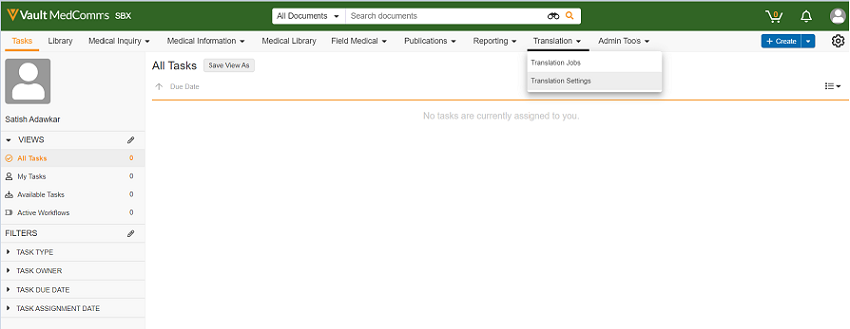
- In Translation Settings, click Languages, and select Source Languages and Target Languages, then Click Save.
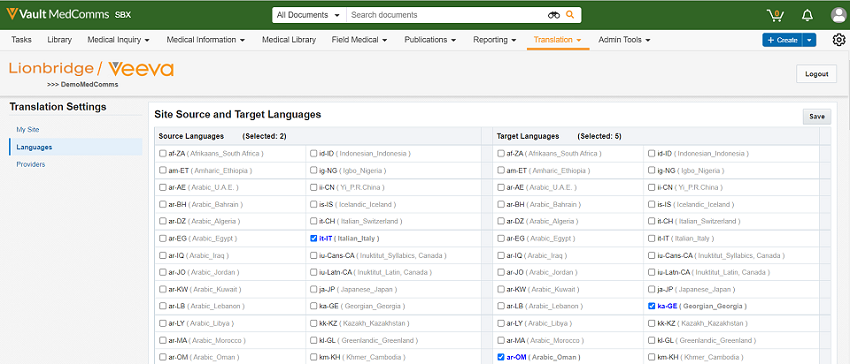
- In Translation Settings, click New Provider and provide Product Name, Product Keys, select Custom Source Languages and Custom Target Languages and click Add.
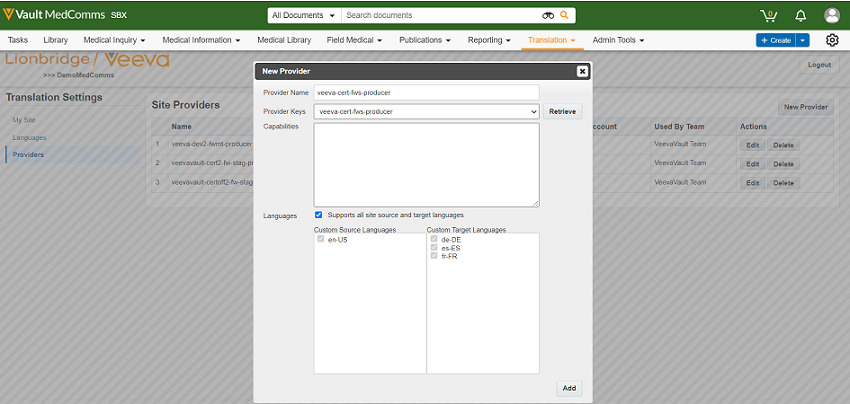
- You can click Edit or Delete the existing Providers.

1.11 - Appendix Language Codes
The Connector has the following language codes:
| Language Identifier |
Language Code |
| Afrikaans (South Africa) |
af-ZA |
| Albanian (Albania) |
sq-AL |
| Alsatian (France) |
gsw-FR |
| Amharic (Ethiopia) |
am-ET |
| Arabic (Algeria) |
ar-DZ |
| Arabic (Bahrain) |
ar-BH |
| Arabic (Egypt) |
ar-EG |
| Arabic (Iraq) |
ar-IQ |
| Arabic (Jordan) |
ar-JO |
| Arabic (Kuwait) |
ar-KW |
| Arabic (Lebanon) |
ar-LB |
| Arabic (Libya) |
ar-LY |
| Arabic (Morocco) |
ar-MA |
| Arabic (Oman) |
ar-OM |
| Arabic (Qatar) |
ar-QA |
| Arabic (Saudi Arabia) |
ar-SA |
| Arabic (Syria) |
ar-SY |
| Arabic (Tunisia) |
ar-TN |
| Arabic (U.A.E.) |
ar-AE |
| Arabic (Yemen) |
ar-YE |
| Armenian (Armenia) |
hy-AM |
| Assamese (India) |
as-IN |
| Azeri (Cyrillic, Azerbaijan) |
az-Cyrl-AZ |
| Azeri (Latin, Azerbaijan) |
az-Latn-AZ |
| Bashkir (Russia) |
ba-RU |
| Basque (Basque) |
eu-ES |
| Belarusian (Belarus) |
be-BY |
| Bengali (Bangladesh) |
bn-BD |
| Bengali (India) |
bn-IN |
| Bosnian (Cyrillic, Bosnia and Herzegovina) |
bs-Cyrl-BA |
| Bosnian (Latin, Bosnia and Herzegovina) |
bs-Latn-BA |
| Breton (France) |
br-FR |
| Bulgarian (Bulgaria) |
bg-BG |
| Catalan (Catalan) |
ca-ES |
| Chinese (Simplified,P.R.China) |
zh-CN |
| Chinese (Simplified,Singapore) |
zh-SG |
| Chinese (Traditional, Hong Kong S.A.R.) |
zh-HK |
| Chinese (Traditional, Macao S.A.R.) |
zh-MO |
| Chinese (Traditional, Taiwan) |
zh-TW |
| Corsican (France) |
co-FR |
| Croatian (Croatia) |
hr-HR |
| Croatian (Latin, Bosnia and Herzegovina) |
hr-BA |
| Czech (Czech Republic) |
cs-CZ |
| Danish (Denmark) |
da-DK |
| Dari (Afghanistan) |
prs-AF |
| Divehi (Maldives) |
dv-MV |
| Dutch (Belgium) |
nl-BE |
| Dutch (Netherlands) |
nl-NL |
| English (Australia) |
en-AU |
| English (Belize) |
en-BZ |
| English (Canada) |
en-CA |
| English (India) |
en-IN |
| English (Ireland) |
en-IE |
| English (Jamaica) |
en-JM |
| English (Malaysia) |
en-MY |
| English (New Zealand) |
en-NZ |
| English (Philippines) |
en-PH |
| English (Singapore) |
en-SG |
| English (South Africa) |
en-ZA |
| English (Trinidad and Tobago) |
en-TT |
| English (United Kingdom) |
en-GB |
| English (United States) |
en-US |
| English (Zimbabwe) |
en-ZW |
| Estonian (Estonia) |
et-EE |
| Faroese (Faroe Islands) |
fo-FO |
| Filipino (Philippines) |
fil-PH |
| Finnish (Finland) |
fi-FI |
| French (Belgium) |
fr-BE |
| French (Canada) |
fr-CA |
| French (France) |
fr-FR |
| French (Luxembourg) |
fr-LU |
| French (Monaco) |
fr-MC |
| French (Switzerland) |
fr-CH |
| Frisian (Netherlands) |
fy-NL |
| Galician (Galician) |
gl-ES |
| Georgian (Georgia) |
ka-GE |
| German (Austria) |
de-AT |
| German (Germany) |
de-DE |
| German (Liechtenstein) |
de-LI |
| German (Luxembourg) |
de-LU |
| German (Switzerland) |
de-CH |
| Greek (Greece) |
el-GR |
| Greenlandic (Greenland) |
kl-GL |
| Gujarati (India) |
gu-IN |
| Hausa (Latin, Nigeria) |
ha-Latn-NG |
| Hebrew (Israel) |
he-IL |
| Hindi (India) |
hi-IN |
| Hungarian (Hungary) |
hu-HU |
| Icelandic (Iceland) |
is-IS |
| Igbo (Nigeria) |
ig-NG |
| Indonesian (Indonesia) |
id-ID |
| Inuktitut (Latin, Canada) |
iu-Latn-CA |
| Inuktitut (Syllabics, Canada) |
iu-Cans-CA |
| Irish (Ireland) |
ga-IE |
| isiXhosa (South Africa) |
xh-ZA |
| isiZulu (South Africa) |
zu-ZA |
| Italian (Italy) |
it-IT |
| Italian (Switzerland) |
it-CH |
| Japanese (Japan) |
ja-JP |
| K’iche (Guatemala) |
qut-GT |
| Kannada (India) |
kn-IN |
| Kazakh (Kazakhstan) |
kk-KZ |
| Khmer (Cambodia) |
km-KH |
| Kinyarwanda (Rwanda) |
rw-RW |
| Kiswahili (Kenya) |
sw-KE |
| Konkani (India) |
kok-IN |
| Korean (Korea) |
ko-KR |
| Kyrgyz (Kyrgyzstan) |
ky-KG |
| Lao (Lao P.D.R.) |
lo-LA |
| Latvian (Latvia) |
lv-LV |
| Lithuanian (Lithuania) |
lt-LT |
| Lower Sorbian (Germany) |
dsb-DE |
| Luxembourgish (Luxembourg) |
lb-LU |
| Macedonian (Former Yugoslav Republic of Macedonia) |
mk-MK |
| Malay (Brunei Darussalam) |
ms-BN |
| Malay (Malaysia) |
ms-MY |
| Malayalam (India) |
ml-IN |
| Maltese (Malta) |
mt-MT |
| Maori (New Zealand) |
mi-NZ |
| Mapudungun (Chile) |
arn-CL |
| Marathi (India) |
mr-IN |
| Mohawk (Mohawk) |
moh-CA |
| Mongolian (Cyrillic, Mongolia) |
mn-MN |
| Mongolian (Mongolian, P.R.China) |
mn-Mong-CN |
| Nepali (Nepal) |
ne-NP |
| Norwegian, Nynorsk (Norway) |
nn-NO |
| Norwegian (Norway) |
nb-NO |
| Occitan (France) |
oc-FR |
| Oriya (India) |
or-IN |
| Pashto (Afghanistan) |
ps-AF |
| Persian (Iran) |
fa-IR |
| Polish (Poland) |
pl-PL |
| Portuguese (Brazil) |
pt-BR |
| Portuguese (Portugal) |
pt-PT |
| Punjabi (India) |
pa-IN |
| Quechua (Bolivia) |
quz-BO |
| Quechua (Peru) |
quz-PE |
| Quechua (Peru) |
es-PE |
| Quechua (Quechua) |
quz-EC |
| Romanian (Romania) |
ro-RO |
| Romansh (Switzerland) |
rm-CH |
| Russian (Russia) |
ru-RU |
| Sami, Inari (Finland) |
smn-FI |
| Sami, Lule (Norway) |
smj-NO |
| Sami, Lule (Sweden) |
smj-SE |
| Sami, Northern (Finland) |
sv-FI |
| Sami, Northern (Norway) |
se-NO |
| Sami, Northern (Sweden) |
se-SE |
| Sami, Skolt (Finland) |
sms-FI |
| Sami, Southern (Norway) |
sma-NO |
| Sami, Southern (Sweden) |
sma-SE |
| Sanskrit (India) |
sa-IN |
| Scottish (United Kingdom) |
gd-GB |
| Serbian (Cyrillic, Bosnia and Herzegovina) |
sr-Cyrl-BA |
| Serbian (Cyrillic, Montenegro) |
sr-Cyrl-ME |
| Serbian (Cyrillic, Serbia) |
sr-Cyrl-RS |
| Serbian (Latin, Bosnia and Herzegovina) |
sr-Latn-BA |
| Serbian (Latin, Montenegro) |
sr-Latn-ME |
| Serbian (Latin, Serbia) |
sr-Latn-RS |
| Serbian (Latin, Serbia and Montenegro) |
sr-Latn-CS |
| Sesotho sa Leboa (South Africa) |
nso-ZA |
| Setswana (South Africa) |
tn-ZA |
| Sinhala (Sri Lanka) |
si-LK |
| Slovak (Slovakia) |
sk-SK |
| Slovenian (Slovenia) |
sl-SI |
| Spanish (Argentina) |
es-AR |
| Spanish (Bolivarian Republic of Venezuela) |
es-VE |
| Spanish (Bolivia) |
es-BO |
| Spanish (Chile) |
es-CL |
| Spanish (Colombia) |
es-CO |
| Spanish (Costa Rica) |
es-CR |
| Spanish (Dominican Republic) |
es-DO |
| Spanish (Ecuador) |
es-EC |
| Spanish (El Salvador) |
es-SV |
| Spanish (Guatemala) |
es-GT |
| Spanish (Honduras) |
es-HN |
| Spanish (Nicaragua) |
es-NI |
| Spanish (Panama) |
es-PA |
| Spanish (Paraguay) |
es-PY |
| Spanish (Puerto Rico) |
es-PR |
| Spanish (Spain) |
es-ES |
| Spanish (United States) |
es-US |
| Spanish (Uruguay) |
es-UY |
| Swedish (Finland) |
sv-FI |
| Swedish (Sweden) |
sv-SE |
| Syriac (Syria) |
syr-SY |
| Tajik (Cyrillic, Tajikistan) |
tg-Cyrl-TJ |
| Tamazight (Latin, Algeria) |
tzm-Latn-DZ |
| Tamil (India) |
ta-IN |
| Tatar (Russia) |
tt-RU |
| Telugu (India) |
te-IN |
| Thai (Thailand) |
th-TH |
| Tibetan (P.R.China) |
bo-CN |
| Turkish (Turkey) |
tr-TR |
| Turkmen (Turkmenistan) |
tk-TM |
| Ukrainian (Ukraine) |
uk-UA |
| Upper Sorbian (Germany) |
hsb-DE |
| Urdu (Islamic Republic of Pakistan) |
ur-PK |
| Uyghur (P.R.China) |
ug-CN |
| Uzbek (Cyrillic, Uzbekistan) |
uz-Cyrl-UZ |
| Uzbek (Latin, Uzbekistan) |
uz-Latn-UZ |
| Vietnamese (Vietnam) |
vi-VN |
| Welsh (United Kingdom) |
cy-GB |
| Wolof (Senegal) |
wo-SN |
| Yakut (Russia) |
sah-RU |
| Yi (P.R.China) |
ii-CN |
| Yoruba (Nigeria) |
yo-NG |
2 - User Guide
2.1 - Welcome to the Connector for Veeva Vault
Welcome to the Lionbridge Connector for Veeva Vault (“Connector”) version 1.0.0. The Connector enables you to manage the translation lifecycle effectively in Veeva Vault. The Connector facilitates built-in review work-flows in which, the files or documents pass through a review workflow before and after the translation. The translations are done quick and easy with this Connector.
2.1.1 - The Translation Lifecycle
The translation lifecycle is the broad process of selecting content, sending it out for translation, and then receiving the translated content back from translation.
This set of steps usually fits inside a larger, more general process called the content lifecycle, which is the process of creating, reviewing, editing, approving, and publishing content.
When you consider the translation lifecycle and the content lifecycle together, you have the global content value chain, which is the strategy for managing multilingual content.
Remember that localizing content is a subset of steps in the broader content lifecycle. This will improve your focus on key localization considerations, improve processes, and keep all content stakeholders included. Together, this results in better content management.
2.1.2 - How the Connector Helps You Manage Your Translation Lifecycle
The Lionbridge Connector for Veeva Vault (Connector) is a plug-in module for Veeva Vault. The Connector features enable you to select, send, monitor, and retrieve content for translation into any language Veeva Vault supports.
These features automate the process, which reduces the effort and time required to export and re-import content that needs to be localized. This is very helpful when translating large volumes of content or ensuring that translated content is quickly re-imported to meet deadlines.
When you use the Connector, you manage your translation lifecycle entirely within the Veeva Vault:
- The Connector exports your content from Veeva Vault in XML format and delivers these content files to the Content API Platform.
- The Content API Platform delivers your content to your translation providers, based on routing rules that your company chooses and the Lionbridge Connector Team implements.
- When the translated content is ready, the Content API retrieves it from your translators and delivers it to the Connector.
- The Connector automatically re-imports the content into the correct location in Veeva Vault.
You can then review, revise, reject, or publish the translated content as needed.
Note: Neither the Connector nor the Content API performs any translation. Similarly, the Lionbridge Connector Team does not provide any translation services. Your company chooses the translation provider that performs the translation.
2.1.3 - Using this Guide
Purpose of this guide
This guide describes how to use the Lionbridge Connector (Connector) for Veeva Vault to manage your translation lifecycle. It describes how to send Veeva Vault components for translation and receive them back from translation.
Who should use this guide
This guide is intended for content editors, project, marketing, localization or translation managers, or others who are responsible for creating, editing, or approving content for translation that resides in your Veeva Vault CMS. This guide is also useful for translation providers who receive content from your Veeva Vault CMS, because it describes your company’s translation management process.
What your company setup should be
This document assumes that:
- Your company already has a functioning instance of Veeva Vault.
- The Lionbridge Connector for Veeva Vault (Connector) has been implemented, configured, and tested on your Veeva Vault CMS.
- The Lionbridge Connector Team has set up the Content API Platform to send content to your translation providers.
If Lionbridge is your company’s translation provider, it assumes that Freeway is already set up for your company.
What you should already know
This document assumes that:
- You are familiar with the Connector’s configuration for your Veeva Vault CMS, and the reasons for choosing certain configuration options. This is important because your company’s configuration determines which features are available.
- You have a strong working knowledge of the Veeva Vault Content Editor.
- You are familiar with your company’s translation process and requirements.
- You have valid user credentials to log into Veeva Vault.
- You have the required permissions to access the Connector functionality described in this guide.
Note: Not all the features described in this guide may be available. Feature availability depends on both your company’s Connector setup and the roles to which you are assigned. If you cannot access functionality that you need, contact your company’s Veeva Vault administrator.
How this guide is organized
This guide contains the following chapters:
How to find out more about the Lionbridge Connector for Veeva Vault
For information on installing and configuring the Lionbridge Connector for Veeva Vault, read the Lionbridge Connector for Veeva Vault Installation and Configuration Guide.
Documentation conventions
This guide uses the following conventions:
| Convention |
Description |
| Bold |
Highlights screen elements such as buttons, menu items, and fields. |
| Courier |
Highlights input, file names, and paths. |
| Italics |
Highlights terms for emphasis, variables, or document titles. |
| > |
Indicates a menu choice. For example, “Select Admin Tools > Configuration.” |
2.1.4 - How to Contact Lionbridge Connector Support
You can submit a support ticket either:
See also:
2.2 - Submitting Documents for Translation
This section talks about the process of submitting one or more documents to Lionbridge for translation. It also covers the approval and rejection process for the translated documents returned from Lionbridge.
The following ways are available for users to send one or more documents to translation:
2.2.1 - Submitting a Single Document for Translation
Veeva Vault allows users to submit single document to Lionbridge for translation through the configured user action Send for Translation on the document.
Prerequisites:
Ensure that the following requirements are met for a document that is to be sent for translation.
- Document type must be Material.
- Document must be in the following states:
- Approved for Distribution
- Approved for Production
NOTE: These requirements are based on the out-of-the-box functionality. Vault Administrators may provide this user action to additional document types and states.
Procedure:
To submit a single document for translation to Lionbridge:
-
From the Library tab, click on the document intended for translation.

-
When the document opens, click the settings icon  in the top right corner and select Send for Translation.
in the top right corner and select Send for Translation.

-
Select the Source and Target languages in the Create Translation Job page.
The Source and Target Language drop-downs contain the languages determined by the Translation Provider specified.
Note: Users can select multiple Target Languages, but any of the selected Target languages must not be same as the selected Source Language.
-
Complete all the required fields and click Save.

-
To view your newly created translation job, go to Translation tab > Recent Translation Jobs, and select the job created.

-
The job state now changes to the Pending Translation state. This state confirms that the job has been submitted to Lionbridge. It also indicates that the translation job is either being processed for translation or the translation has been completed, and the Target Documents are awaiting approval.
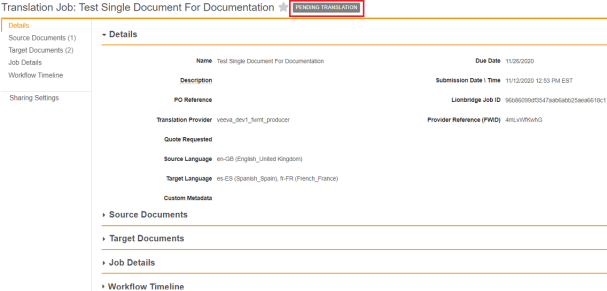
-
Veeva Vault automatically generates two separate objects to support the translation. One for Source Documents and the other for Target Documents.
Source Documents object contains the object representation of the documents to be translated. The user must not interface with the Source Documents as they are used by the Connector.
The Target Documents are placeholder objects which are used to store the translated documents returned from Lionbridge after the translation is completed. Approvals and Rejections of translated documents take place here. The Connector creates one Target Document record for each Target Language specified.

NOTE: Redelivery should NOT happen for completed and inactive jobs.
2.2.2 - Submitting Multiple Documents for Translation
Veeva Vault allows users to submit multiple documents to Lionbridge for translation through the configured user action Send for Translation on the Translation Job object.
Prerequisites:
Before sending the documents for translation, ensure that each document must be in the following states:
- Approved for Distribution
- Approved for Production.
NOTE: This requirement is based on the out-of-the-box functionality. Veeva Vault Administrators may provide this user action to additional document types and states.
Procedure:
To create a Translation job for submitting multiple documents for translation:
-
Select the available Translation Jobs under the Translation menu and click the Create button in the top right corner.

-
The user is navigated to the Create Translation Job page, select Source and Target languages.
The Source and Target Language drop-downs contain the languages determined by the Translation Provider specified.
Note: Users can select multiple Target Languages, but any of the selected Target languages must not be the same as the selected Source Language.
- Complete all the required fields and click Save.
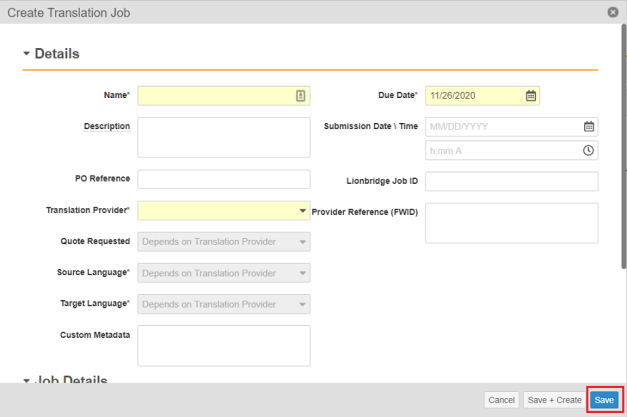
- To add documents to the newly created job, select the Source Documents drop-down and click Create.
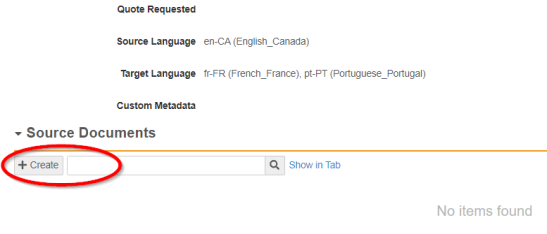
- Specify the document intended for translation in the Create Translation Job to Document page and click Save.
To submit any additional documents that need to be translated from the same Source Language into the same Target Languages, repeat Step 1 to Step 5.
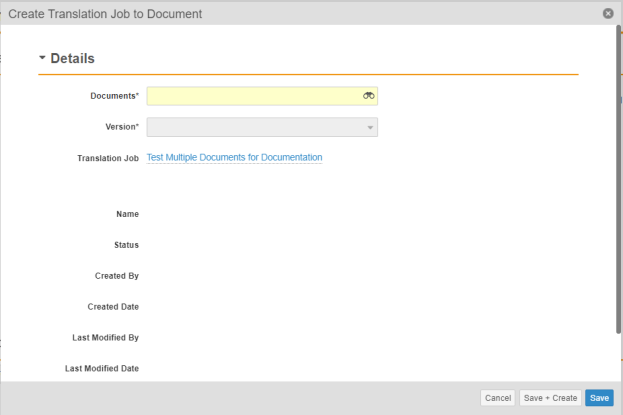
- A Source Document record is created for each document added to the Translation Job.
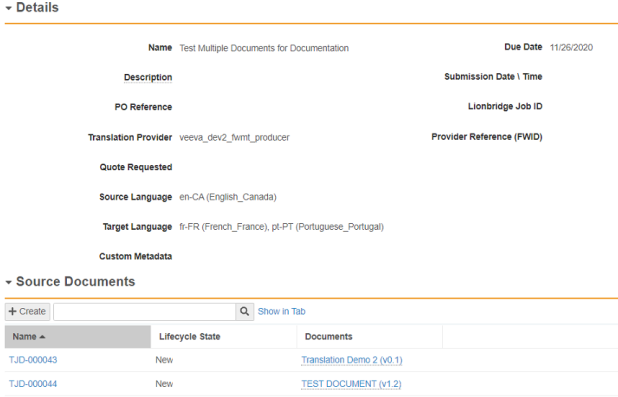
- When all the documents are added to the job and you are ready to submit the job to Lionbridge for translation, click the settings icon in the top right corner of the Translation Job and select Send for Translation.
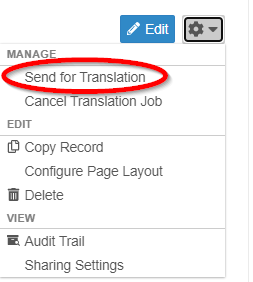
- The job state now changes to the Pending Translation state. This state confirms that the job has been submitted to Lionbridge. It also indicates that the translation job is either being processed for translation or the translation has been completed, and the Target Documents are awaiting approval.
Veeva Vault automatically generates Target Document records. The Target Documents are placeholder objects used to store the translated documents returned from Lionbridge after the translation is completed. Approvals and Rejections of translated documents take place here. The Connector creates one Target Document record for each Target Language specified multiplied by the number of Source Documents added to the job.
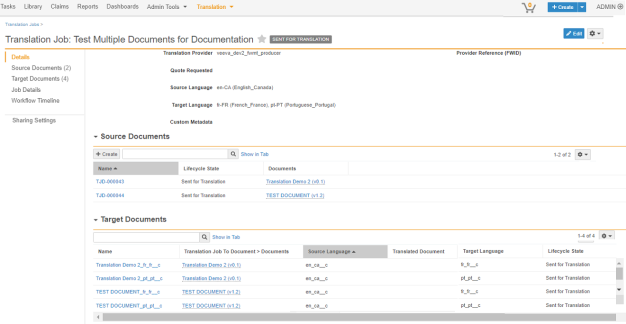
NOTE: Redelivery should NOT happen for completed and inactive jobs.
2.3 - Reviewing Translated Document
Once a job has reached the Pending Translation state and the Translated Document field is populated on a Target Document column, the Target Document moves to the Ready For Translation Approval state. You can initiate the approval process for this record.
The reviewing of the translated document is done in 3 sections:
-
Review translated document:
-
If the Target Document is in the Ready For Translation Approval state, click on the settings icon  and select Start Translation Approval user action to begin the Translation Approval workflow.
and select Start Translation Approval user action to begin the Translation Approval workflow.

-
Select Due Date, and Translation Approver(s) from the drop-down and choose the approver(s) names and click Start.
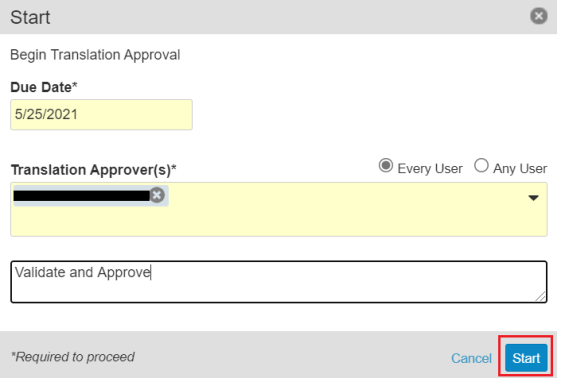
-
The Translated Target Document moves to the Pending Translation Approval state.
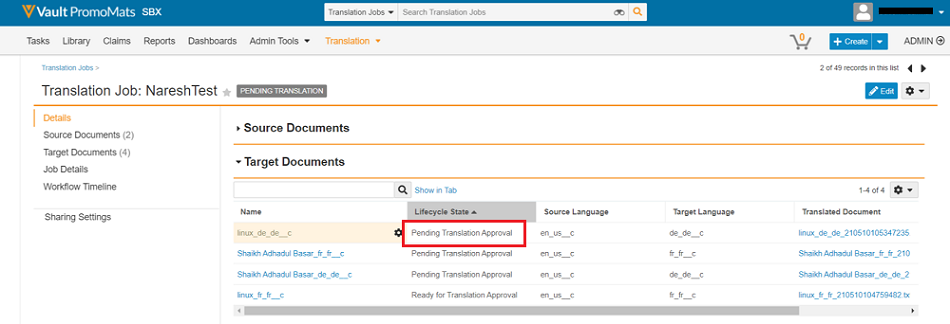
-
The corresponding user receives a notification informing them that there is a document awaiting in their My Tasks.
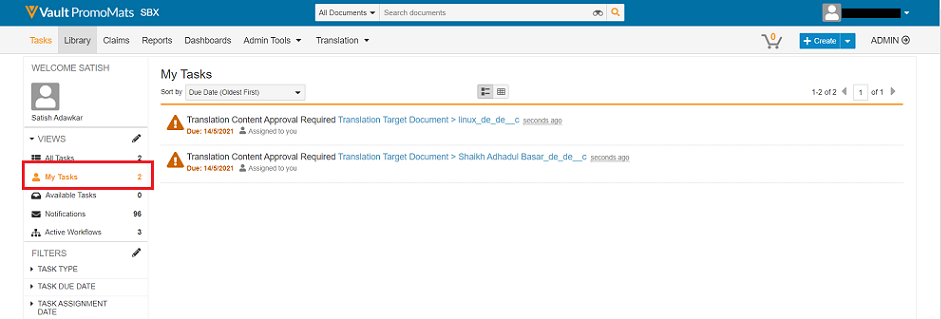
-
Approve translated document:
-
To complete the Translation Approval workflow, approver need to open a specific document and click Complete.
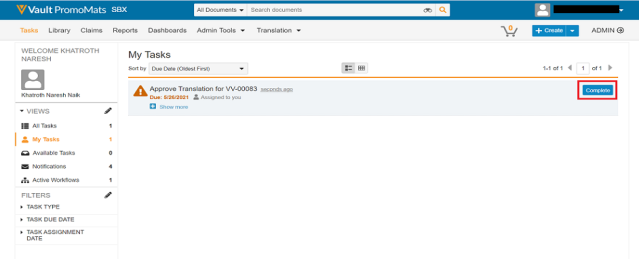
-
To provide Approval for translation. Select Role from the dropdown and choose Approved, and click Complete.
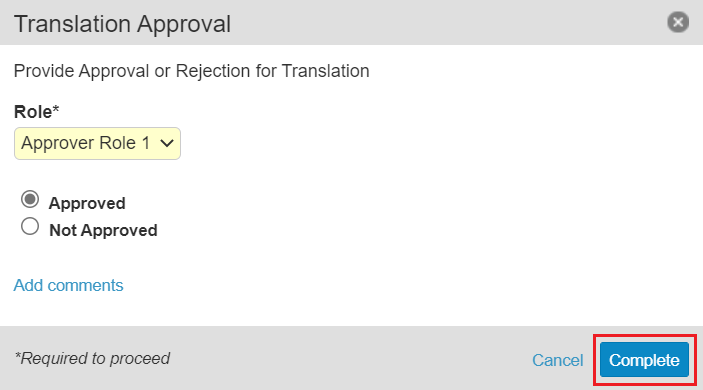
-
If the Translation Approved verdict is selected, the Translation Target Document moves to the Translation Approved state.
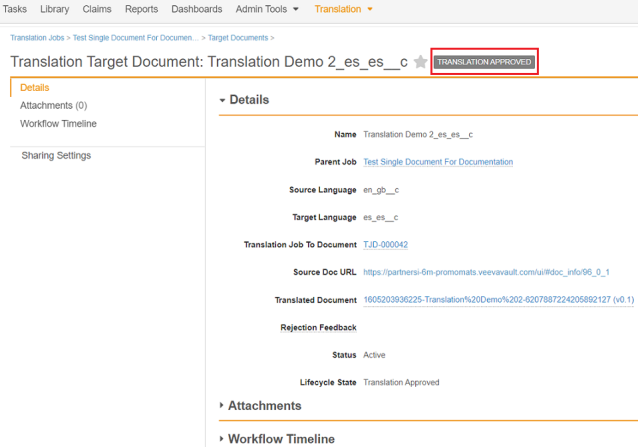
-
Reject translation document.
-
To provide Rejection for translation. Select Role from the dropdown and choose Not Approved and enter Rejection Feedback comments indicating why this translation was not approved, and click Complete.

-
The Translation Target Document moves to the Translation Not Approved status and the Rejection Feedback is stored in the record.
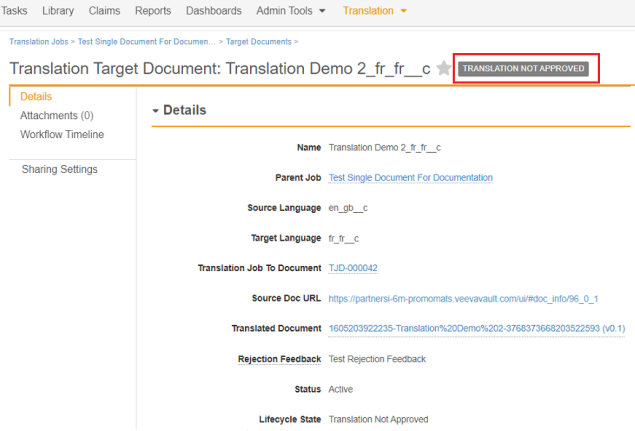
Note: When all the documents in a particular job is approved by all the corresponding users listed in the translator approver(s) list, then only job status is displayed as Completed. Else, the job gets rejected, and the status remains as Pending Translation.
NOTE: Redelivery should NOT happen for completed and inactive jobs.


























